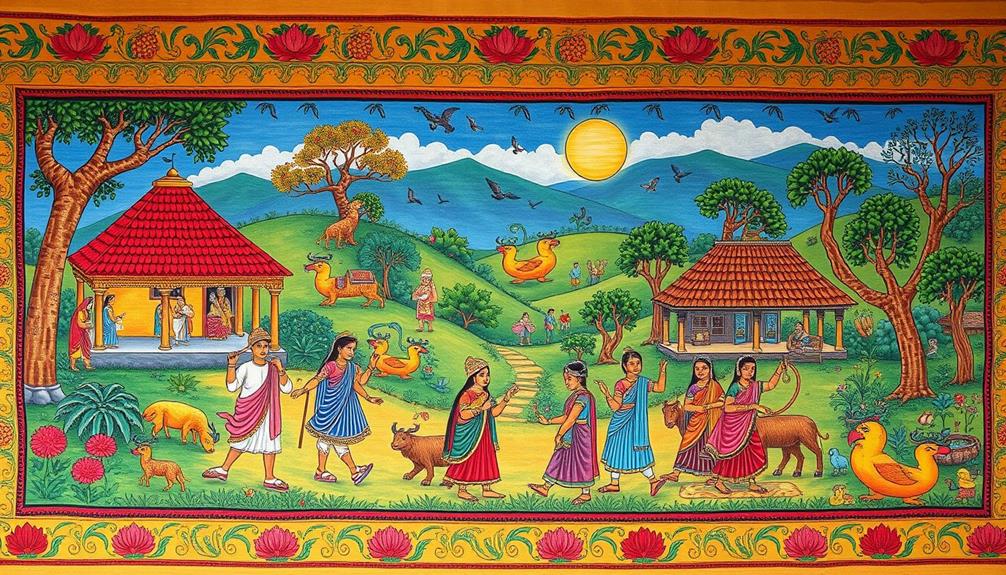You're stepping into the vibrant world of Patua scroll painting, a tradition that dates back to the 12th century in Bengal. Patuas, historically seen as priest-like figures, narrate stories through intricate designs. Their scrolls mix themes from Hindu epics with modern events, offering both cultural and social commentary. Contemporary artists like Gurupada Chitrakar blend old narratives with today's issues, using eco-friendly methods to create eye-catching pieces. This art form is more than just storytelling; it's a reflection of resilience and creativity in the face of change. There's much more waiting for you to discover about this fascinating tradition.
Key Takeaways
- Patua art, originating in Bengal, dates back to the 12th century, representing a rich cultural and historical tradition through storytelling.
- Scrolls depict a variety of themes, including Hindu epics and contemporary events, showcasing the evolution of narratives over time.
- Contemporary artists like Gurupada Chitrakar combine traditional techniques with modern themes, enhancing relatability while adhering to eco-friendly practices.
- The art form serves as social commentary, addressing important issues such as communal harmony and resilience in the face of adversity.
- Educational initiatives and exhibitions have increased visibility and appreciation for Patua art, connecting artists with broader audiences and fostering cultural preservation.
Historical Background of Patua Art
The rich heritage of Patua art reveals a vibrant tapestry of storytelling woven through painted scrolls, known as patas. Originating in Bengal, this art form boasts historical roots dating back to the 12th century.
As a Patua, you'd be part of a community of artists renowned for their ability to narrate stories through visual art and song, much like the way modern farmhouse decor trends emphasize storytelling through design. Traditionally, Patuas held a priest-like status within the Santhal community, performing at significant life events, showcasing the cultural importance of this narrative tradition.
Evidence of Patua scrolls from the 18th century highlights their role in storytelling, particularly during festivals like Durga Puja. Despite facing a decline during British colonial rule, Patua art witnessed a resurgence in the 20th century, largely due to the efforts of figures like Gurusaday Dutt. He championed this folk art, emphasizing its significance in preserving cultural narratives.
Today, you can appreciate how Patua scrolls not only reflect historical events but also embody the essence of Bengali folklore. This art form serves as a vital link between past and present, ensuring that these rich stories continue to resonate with future generations.
Themes and Subjects in Scrolls
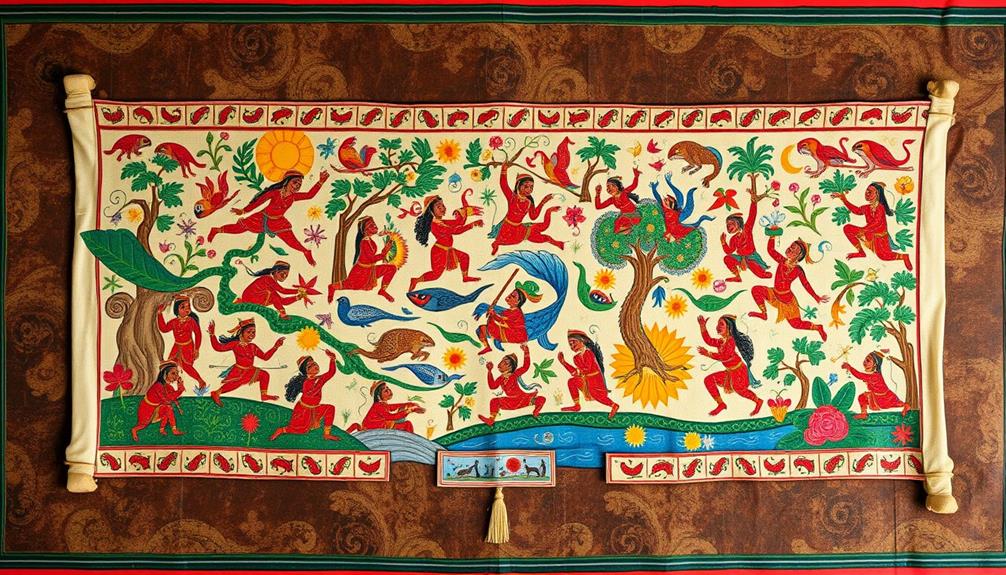
Patua scrolls burst with narratives that capture a wide range of themes, blending ancient tales with modern issues. You'll find that these scrolls often depict stories from Hindu epics like the Ramayana and Mahabharata, showcasing traditional subjects alongside contemporary issues.
The artistic expression in Patua scrolls doesn't just reflect folklore; it also addresses modern events, such as the 2004 Tsunami and the September 11 attacks. This blend of storytelling not only enhances cognitive development but also fosters emotional well-being through creative expression, much like the benefits of play in learning.
Notable subjects include the enchanting tales of Radha and Krishna, which celebrate love and devotion, while communal narratives emphasize religious tolerance. Different types of patas, like Satyapir Pata and Manasa Pata, highlight unique cultural significance and integrate local beliefs and rituals into the artwork.
As you explore these scrolls, you'll notice how intricate designs, vibrant colors, and decorative motifs enhance storytelling. Each piece combines visual elements with oral narratives during performances, making the experience immersive.
The shift of themes from traditional folklore to modern socio-political commentary reflects the evolving nature of Patua art, ensuring its relevance to contemporary audiences in Bengal and beyond.
Contemporary Patua Artists and Their Work
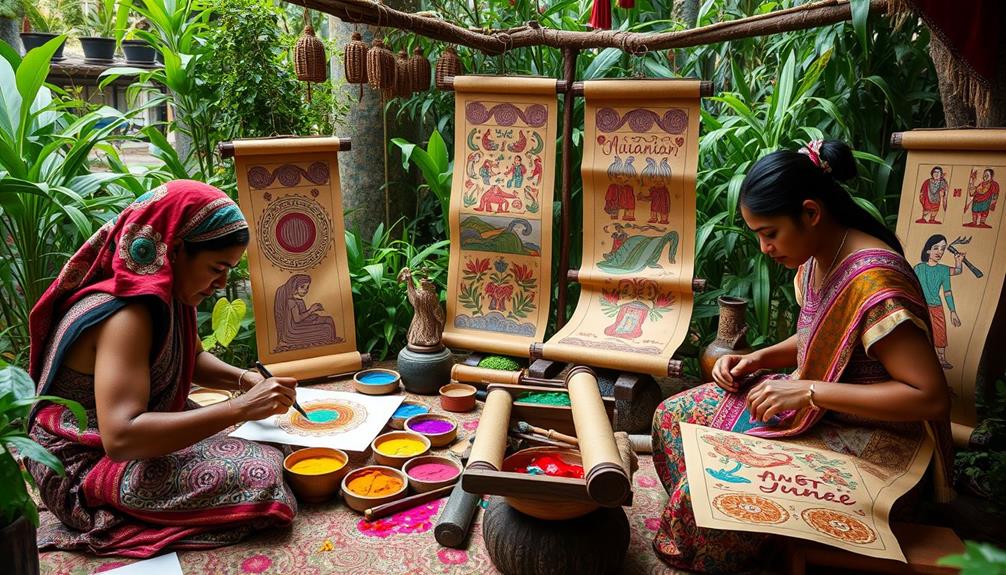
How do contemporary artists breathe new life into the ancient Patua tradition? Artists like Gurupada Chitrakar and Montu Chitrakar are redefining patachitra with their innovative approach to scroll paintings. They blend traditional storytelling with modern themes, tackling subjects like the 2004 Tsunami and the September 11 attacks. This adaptability showcases the resilience of this Indian folk art, much like how mushroom coffee offers health benefits through its unique properties.
Their commitment to eco-friendly practices shines through in their work. By using vegetable dyes and handmade paper, they guarantee their art is sustainable.
The following elements highlight their contributions to contemporary art:
- Vibrant Colors: The use of water-based paints brightens their scrolls, capturing attention and imagination.
- Cultural Fusion: They weave modern narratives into traditional formats, making the art relatable to today's audience.
- Increased Visibility: Exhibitions like "Village of Painters: Narrative Scrolls from West Bengal" help elevate patachitra on international platforms.
Through their efforts, Gurupada and Montu not only preserve the essence of this art form but also invite new generations to appreciate and engage with these contemporary patua paintings.
Cultural Significance and Social Context
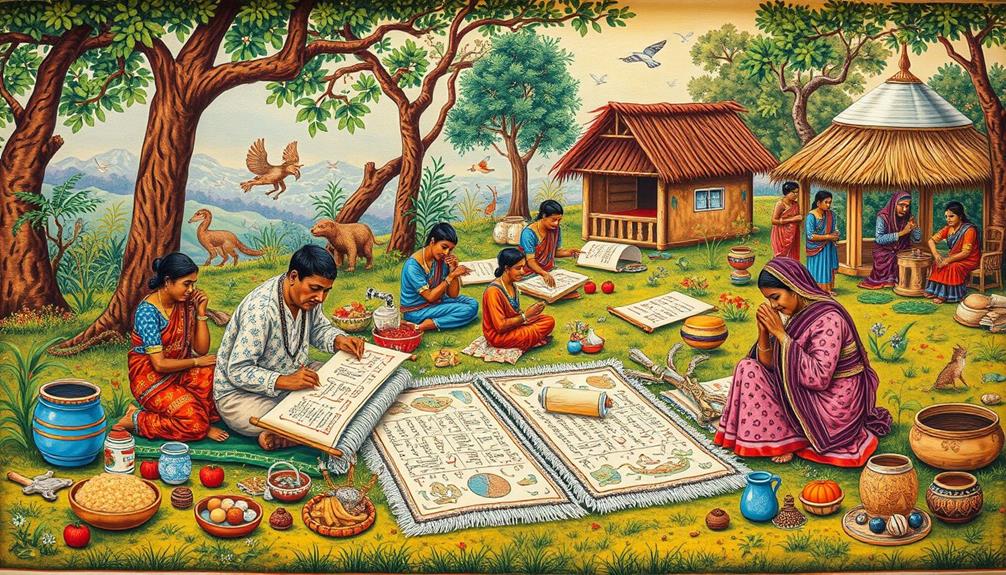
Emerging from a rich tapestry of history, the Patua tradition embodies the resilience and creativity of the Patuas, a community of artists in West Bengal. These artists have preserved their cultural heritage through storytelling, using their paintings to convey powerful messages. Often self-taught, Patuas belong to the Chitrakar caste and have mastered artistic techniques passed down through generations, blending visual art with oral narratives. Their art serves as a form of social commentary, much like how team-based games foster bonding among friends.
Historically, Patuas performed at significant life events, such as festivals and weddings, enchanting audiences with their scrolls. Their works often depict themes of communal harmony and religious tolerance, reflecting the socio-political dynamics of their surroundings. Events like the communal riots, the 2004 Tsunami, and the September 11 attacks have influenced their storytelling, allowing them to comment on contemporary issues.
Today, the evolution of Patua art has garnered increased visibility, with exhibitions showcasing their unique storytelling and attracting interest from collectors and art enthusiasts alike. This growing recognition not only highlights the artistic value of Patua paintings but also affirms their role in fostering understanding and appreciation of diverse cultural narratives in a rapidly changing world.
Educational and Institutional Support
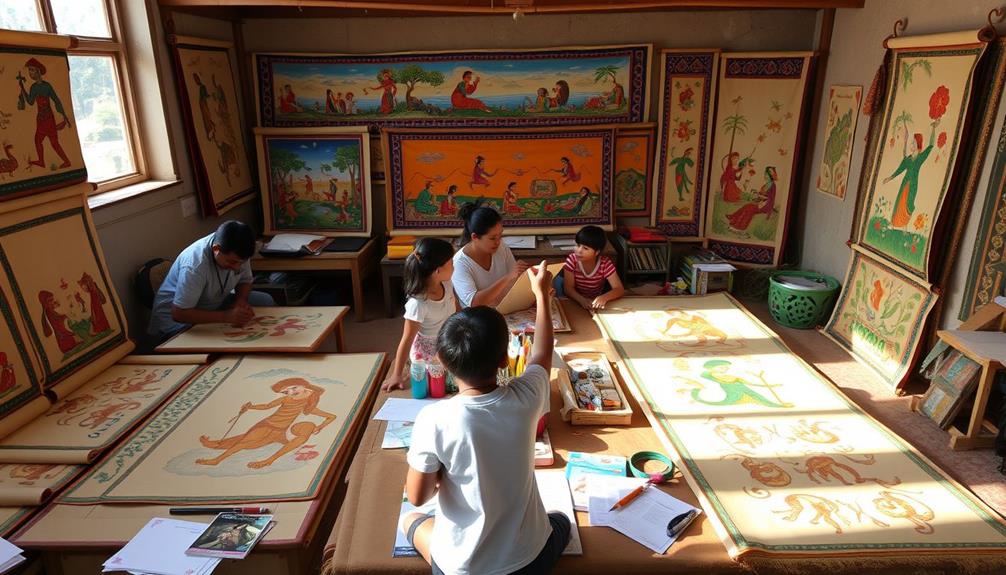
In recent years, educational and institutional support has played an essential role in revitalizing the Patua art tradition. Organizations like MAP Academy have provided valuable resources and events that enhance visibility and understanding of patua art, similar to how community forums and platforms facilitate hackathon discovery. Their efforts focus on educational initiatives designed to engage the community and promote the artisanal family's legacy.
Through various outreach and engagement activities, online events and fellowships help artists connect with broader audiences. Collaborations between patua artists and cultural organizations are critical for the preservation of traditions and guaranteeing the cultural legacy of this art form.
Here are some key aspects of this support:
- Increased visibility: Social media platforms like Instagram and LinkedIn allow artists to showcase their work, fostering audience engagement.
- Community support: Educational initiatives keep the patua community informed and connected, driving public awareness.
- Cultural preservation: Collaborations guarantee that patua art remains vibrant and is passed down through generations.
This synergy between institutions and artists is fundamental for sustaining interest in patua art, allowing it to flourish in contemporary settings while honoring its rich heritage.
Frequently Asked Questions
What Is the Tradition of the Patua?
The Patua tradition involves creating narrative scrolls that tell stories through vibrant visuals and oral performances. You'll find themes ranging from ancient epics to contemporary issues, showcasing a rich cultural heritage that's been passed down through generations.
What Is the Traditional Art of Scroll Painting of Bengal Known As?
You'll find the traditional art of scroll painting in Bengal known as "Patua," where vibrant colors swirl across fabric, telling tales of gods and heroes while capturing the essence of life, folklore, and culture.
What Is the Traditional Painting of Bengal?
The traditional painting of Bengal features vibrant, narrative scrolls that tell stories through intricate designs and colors. You'll find these artworks often depict significant tales from history, reflecting the region's rich cultural heritage.
What Is Patua Painting?
Patua painting's a vibrant folk art form where you create narrative scrolls that tell stories through visuals and performances. You'll use natural pigments on cloth, blending tradition with contemporary themes to engage audiences effectively.
Conclusion
In exploring the Patua scroll painting tradition of Bengal, you discover not just an art form, but a vibrant storytelling medium. Did you know that over 70% of contemporary Patua artists are under 35 years old? This statistic highlights the tradition's evolution and its appeal to younger generations, ensuring that these rich narratives continue to thrive. Embracing both heritage and modernity, the Patua scrolls remain an essential part of Bengal's cultural landscape, inspiring future storytellers.
